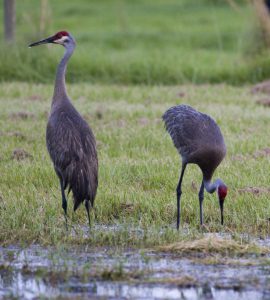Rapid Growth
Celebrate American Wetlands Month in May. According to the US Census Bureau between 2010 and 2020, the number of people per square mile rose by 44% in St. Johns County. This growth means fewer wetlands and fewer wetlands mean fewer native plants and animals. Why is it important to save wetlands? In Florida, there are over 40 species listed as threatened or endangered that live in or are dependent on wetlands and use uplands for nesting and denning. Only a few live in St. Johns County.
Birds on the List

Four birds are on the list, but one stands out among seasoned birders: the wood stork. Several years ago, while birding in St. Marks Wildlife Refuge in Wakulla County, I overheard a couple talk about wood storks. They lamented how they had been all over the state and could not find the elusive wood stork. I had to chuckle. I shared my experience of frequently seeing wood storks in retention ponds around St. Johns County. I suggested they pack up their expensive spotting scope and go east.

While having the wood stork is a good thing, it is only one of a handful of wetland-dependent species that use uplands for nesting or denning in St. Johns County. In fact, there are only three other animals, all birds, that are marsh dependent and on this list. The sandhill crane is the largest bird of the Florida birds to be on the list. The best way to find them is to go to a quiet wetland area and listen for their distinctive call. I have seen them in the morning in a marsh near my house, away from dense human development. Little blue herons eat small fish and amphibians in marshes. Tricolored herons nest in colonies on the edge of the marsh with other wading birds.
Shrinking Wetlands
Reading this list from the Florida Fish and Wildlife Conservation Commission (FWC) showed how few of the animals listed can be found in St. Johns County. Four public access wetlands remain in St. Johns County: Deep Creek Conservation Area, Stokes Landing Conservation Area, Moses Creek Conservation Area, and the Pellicer Creek Corridor, which is on the border of Flagler and St. Johns County. Having only four designated areas left in the county may explain why there are so few animals on the list. I have visited two of the conservation areas and kayaked in the Pellicer Creek Corridor and seen all four of these birds at some point.
Because St. Johns County is one of the most desirable places to live in Florida, the population is rapidly increasing. Due to this growth, these public access wetlands become more important than ever. Learn all you can about wetlands and take the time in May to celebrate American Wetlands Month by visiting at least one of these four wild places. You just might see a wood stork too.
 0
0
